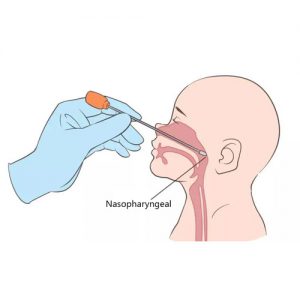Respiratory syncytial virus (RSV) is a very contagious, common viral respiratory infection. RSV testing detects the presence of respiratory syncytial virus in nasal secretions to help diagnose the infection. Acceptable specimens for these tests are nasal/pharyngeal (NP) swabs or nasal washes/aspirations.
Specimen Collection
Nasal/Pharyngeal Swab

Specimen is to be collected on a cotton, rayon, or Dacron swab with an aluminum wire. No wooden shafts allowed. Transport in either the culture swab container provided or in 1 ml sterile saline in a sterile container.
a. Remove excess secretions (runny nose) from the nasal opening using a regular cotton or Dacron swab. Insert the tip of the swab gently into the nose until the white tip is no longer visible and rotate. Withdraw swab and discard into hazardous waste container.
b. Remove the culture swab from the package. Gently pass the swab through the nose and into the nasopharynx. You may need assistance in holding the head of infants and small children so they do not move or jerk their head.
c. Rotate the swab on the nasopharyngeal membrane and allow the swab to remain in place for 10-15 seconds to absorb organisms. Replace swab in the culture swab container or place in 1 ml of sterile saline in a sterile container.
Nasal Washing (saline)
a. Fill plastic pipette with sterile saline and expel small amount into each nostril. (Or if using prepackaged saline aliquots, expel directly from container into nostrils).
b. Aspirate secretions from nose with soft plastic or 5 ml rubber bulb syringe.
c. Expel fluid from pipette into pre-labeled test tube or other suitable specimen container. No fixative should be added.
d. Repeat this procedure at least two times.
e. Wash volumes of 2-3 ml are recommended.
Direct Nasal Aspiration of Secretions:
This technique used only when secretions are excessive.
a. Aspirate nasal secretions from nose with disposable soft plastic pipette or 5 ml rubber bulb syringe or if using the suction apparatus, introduce the small catheter through the nares to the back of the nasopharynx. Apply suction intermittently as the catheter is slowly withdrawn. If enough secretions are not obtained, this process may be repeated once.
b. Expel secretions into labeled test tube or other acceptable collection container. No fixative should be added.
Transport
Transport to lab immediately. Refrigerate if transport time is greater than 1 hour.
Source: Internet

















